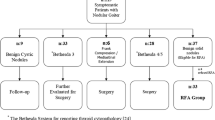Abstract
Background
Some patients with autonomously functioning thyroid nodules (AFTN) are not suitable for surgery or radioiodine therapy. Therefore, minimally invasive alternative treatments, such as ethanol ablation or radiofrequency ablation (RFA), are necessary.
Methods
This study included nine patients (4 toxic and 5 pretoxic patients; male to female ratio = 1:8; mean age, 47 ± 17 (range, 25–71) years) who were not eligible for surgery or radioiodine therapy. All of the patients showed hot nodule with suppression of normal thyroid gland in 99mTc pertechnetate scintigraphy. RFA was performed using a 17- and 18-gauge internally cooled electrode. Nodule volume, thyroid function, scintigraphy, symptom score (visual analogue scale, 0–10 cm), cosmetic grading score (4-point scale), and complications were evaluated before treatment and at 1, 3, and 6 months follow-up.
Results
Mean volume of the index nodule was 14.98 ± 25.53 (range, 0.29–82.29) mL. After RFA it decreased at 1 month (12.01 ± 25.97 mL, p = 0.015), 3 months (7.27 ± 15.13 mL, p = 0.011), 6 months (8.27 ± 21.29 mL, p = 0.008), and the last month (7.57 ± 19.99 mL, p = 0.008). Initial mean T3, fT4, and TSH were 156.2 ± 42.1 ng/dL, 1.73 ± 0.40 ng/dL, and 0.052 ± 0.087 mU/mL, respectively. A significant improvement of mean T3, fT4, and TSH were observed at last follow-up (T3: 116.8 ± 20.7 ng/dL, p = 0.015; fT4: 1.37 ± 0.26 ng/dL, p = 0.036; TSH: 1.454 ± 1.756 mU/mL, p = 0.012). After ablation, four patients became a cold or normal scan and five remained as a hot nodule. The mean symptom and cosmetic grading score was reduced from 2.4 ± 1.7 to 0.6 ± 0.7 (p = 0.011) and from 3.1 ± 1.2 to 1.4 ± 1.0 (p = 0.017), respectively. No major complications were encountered.
Conclusions
RFA seems to be effective and safe for the treatment of AFTN.



Similar content being viewed by others
References
Hegedus L (2004) Clinical practice. The thyroid nodule. N Engl J Med 351:1764–1771
Burch HB, Shakir F (1998) Fitzsimmons TR et al (1998) Diagnosis and management of the autonomously functioning thyroid nodule: the Walter Reed Army Medical Center experience, 1975–1996. Thyroid 8:871–880
Sandrock D, Olbricht T, Emrich D et al (1993) Long-term follow-up in patients with autonomous thyroid adenoma. Acta Endocrinol (Copenh) 128:51–55
Parle JV, Maisonneuve P, Sheppard MC et al (2001) Prediction of all-cause and cardiovascular mortality in elderly people from one low serum thyrotropin result: a 10-year cohort study. Lancet 358:861–865
Toft AD (2001) Clinical practice. Subclinical hyperthyroidism. N Engl J Med 345:512–516
Biondi B, Palmieri EA, Klain M et al (2005) Subclinical hyperthyroidism: clinical features and treatment options. Eur J Endocrinol 152:1–9
Gharib H, Tuttle RM, Baskin HJ et al (2005) Subclinical thyroid dysfunction: a joint statement on management from the American Association of Clinical Endocrinologists, the American Thyroid Association, and the Endocrine Society. J Clin Endocrinol Metab 90:581–587
Spiezia S, Vitale G, Di Somma C et al (2003) Ultrasound-guided laser thermal ablation in the treatment of autonomous hyperfunctioning thyroid nodules and compressive nontoxic nodular goiter. Thyroid 13:941–947
Dossing H, Bennedbaek FN, Hegedus L (2003) Ultrasound-guided interstitial laser photocoagulation of an autonomous thyroid nodule: the introduction of a novel alternative. Thyroid 13:885–888
Dossing H, Bennedbaek FN, Bonnema SJ et al (2007) Randomized prospective study comparing a single radioiodine dose and a single laser therapy session in autonomously functioning thyroid nodules. Eur J Endocrinol 157:95–100
Gazelle GS, Goldberg SN, Solbiati L et al (2000) Tumor ablation with radio-frequency energy. Radiology 217:633–646
Dupuy DE, Goldberg SN (2001) Image-guided radiofrequency tumor ablation: challenges and opportunities—part II. J Vasc Interv Radiol 12:1135–1148
Dupuy D, Monchik J, Decrea C et al (2001) Radiofrequency ablation of regional recurrence from well-differentiated thyroid malignancy. Surgery 130:971–977
Jeong WK, Baek JH, Rhim H et al (2008) Radiofrequency ablation of benign thyroid nodules: safety and imaging follow-up in 236 patients. Eur Radiol 18:1244–1250
Deandrea M, Limone P, Basso E et al (2008) US-guided percutaneous radiofrequency thermal ablation for the treatment of solid benign hyperfunctioning or compressive thyroid nodules. Ultrasound Med Biol 34:784–791
Baek JH, Jeong HJ, Kim YS et al (2008) Radiofrequency ablation for an autonomously functioning thyroid nodule. Thyroid 18:675–676
Dossing H, Bennedbaek FN, Hegedus L (2006) Beneficial effect of combined aspiration and interstitial laser therapy in patients with benign cystic thyroid nodules: a pilot study. Br J Radiol 79:943–947
Sung JY, Baek JH, Kim YS et al (2008) One-step ethanol ablation of viscous cystic thyroid nodules. AJR Am J Roentgenol 191:1730–1733
Pacella CM, Bizzarri G, Spiezia S et al (2004) Thyroid tissue: US-guided percutaneous laser thermal ablation. Radiology 232:272–280
Papini E, Pacella CM, Verde G (1995) Percutaneous ethanol injection (PEI): what is its role in the treatment of benign thyroid nodules? Thyroid 5:147–150
Pacella CM, Bizzarri G, Guglielmi R et al (2000) Thyroid tissue: US-guided percutaneous interstitial laser ablation-a feasibility study. Radiology 217:673–677
Kanauchi H, Mimura Y, Kaminishi M (2001) Percutaneous radio-frequency ablation of the thyroid guided by ultrasonography. Eur J Surg 167:305–307
Kim YS, Rhim H, Tae K et al (2006) Radiofrequency ablation of benign cold thyroid nodules: initial clinical experience. Thyroid 16:361–367
Guglielmi R, Pacella CM, Bianchini A et al (2004) Percutaneous ethanol injection treatment in benign thyroid lesions: role and efficacy. Thyroid 14:125–131
Lippi F, Ferrari C, Manetti L et al (1996) Treatment of solitary autonomous thyroid nodules by percutaneous ethanol injection: results of an Italian multicenter study. The Multicenter Study Group. J Clin Endocrinol Metab 81:3261–3264
Monzani F, Caraccio N, Goletti O et al (1997) Five-year follow-up of percutaneous ethanol injection for the treatment of hyperfunctioning thyroid nodules: a study of 117 patients. Clin Endocrinol (Oxf) 46:9–15
Acknowledgments
The authors thank Hangil Im for assistance.
Author information
Authors and Affiliations
Corresponding author
Rights and permissions
About this article
Cite this article
Baek, J.H., Moon, WJ., Kim, Y.S. et al. Radiofrequency Ablation for the Treatment of Autonomously Functioning Thyroid Nodules. World J Surg 33, 1971–1977 (2009). https://doi.org/10.1007/s00268-009-0130-3
Published:
Issue Date:
DOI: https://doi.org/10.1007/s00268-009-0130-3




